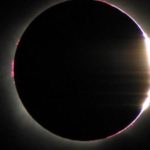Total Solar Eclipses
A total solar eclipse is an awe-inspiring and beautiful astronomical event. A solar eclipse occurs when the moon passes directly between the earth and the sun. Solar eclipses are visible only during the day and occur only during a new moon. In the new moon phase, the moon itself is completely invisible. Therefore, at the beginning of a solar eclipse, the sun appears as a large orange disk with a slow, but growing bite removed from its face.
How eclipses progress
As the moon obscures more of the sun, the sky darkens. If the obscured portion of the sun is 80 percent or less, humans may not notice any darkening, but animals and especially birds apparently can perceive smaller changes in brightness than can people. As a result, those perceptive birds and animals may begin their nocturnal activities while the sky is still bright.
Approaching Totality
In the last few seconds before totality, the last vestiges of the sun’s yellow-orange color fades away, a number of small beads of light (known as Baily’s beads) reach the earth by passing through jagged features such as mountains and valleys on the outer edges of the moon’s disk. As the moon covers more of the sun, the beads disappear until a single bead remains. This solitary bead has an appearance reminiscent of a diamond set in a shining ring. The ring like appearance is known appropriately as the As the final bead disappears, totality begins.
Totality
The totality phase, unfortunately, is relatively brief, lasting a maximum of 7.5 minutes. The totality phase of the eclipse of August 21, 2017, lasted about 2 minutes and 40 seconds at the point of the location of the greatest eclipse and will be a maximum of about 4 minutes and 28 seconds for the eclipse of April 8, 2024. One can obtain details regarding any eclipse occurring between 1950 and 2100, using the Eclipse Planner App for iOS and Android smartphones and tablets.
Annular Eclipses
Annular eclipses occur when the sun and moon are nearly perfectly aligned as is the case for a total solar eclipse. However, in the case of an annular eclipse, the resulting eclipse is not quite total, because the apparent size of the moon is smaller than that of the sun.
The moon’s orbit around the earth has the shape of an ellipse rather than that of a circle. As a result of the elliptical orbit, the earth-moon distance can vary from a minimum at perigee to a maximum when the moon is at apogee.
If an eclipse occurs when the moon is relatively far from the earth, the moon’s disk is smaller than that of the sun. As a result, during such an eclipse, it is impossible for the moon to block the entire disk of the sun. Instead, a bright ring from the sun will be visible around the moon’s disk. This bright ring gives annular eclipses their popular name, the Ring of Fire.
Annular Eclipses are Spectacular too!
Annular eclipses always involve less than 100% obscuring of the sun. This means that the shimmering corona, will not be visible. The sky will not become dark and planets and stars will not become visible. However, people who find themselves in the path of annularity can witness every other feature described above for a total eclipse including Baily’s Beads and the Diamond ring effect. In fact, Baily’s beads are named for Astronomer Francis Baily who observed them during the 1836 Annular eclipse.

